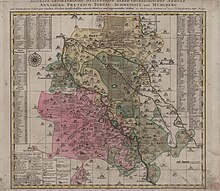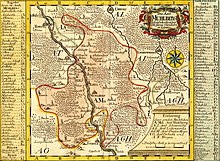Mühlberg Office


The Mühlberg office was an administrative unit of the Electorate of Saxony , which was converted into a kingdom in 1806, and was affiliated to the Meißnische Kreis .
Until it was ceded to Prussia in 1815, as a Saxon office it formed the spatial reference point for the collection of sovereign taxes and compulsory services , for the police , jurisdiction and military service .
Geographical location
The Mühlberg office was in the north of the Meißnische Kreis . For the most part it was east of the Elbe . The territory of the office had a very fragmented structure with numerous exclaves and local parts.
Adjacent administrative units
| Office Schweinitz (exclave) | Liebenwerda Office | Liebenwerda Office |
| Amt Torgau and Stiftsamt Wurzen ( Amt Wurzen (exclave)) |

|
Liebenwerda Office |
| Stiftsamt Wurzen ( Amt Wurzen (exclave)) | Office of Oschatz and Hereditary Office of Meißen | Grossenhain office |
history
Around the city of Mühlberg a rule arose early, which came from the Lords of Ilburg (Eilenburg) to the Margraves of Meißen. In 1443, Elector Friedrich the Meek exchanged the rule of Mühlberg to Heinrich Berka von Dubá for the rule of Hohnstein . After the division of Leipzig in 1485, the office belonged to the Albertine line of the Wettins .
When the descendants of Heinrich Berka von Dubá died out in 1520, the rule of Mühlberg fell back to the Margrave of Meißen as sovereign, who has since appointed his own officials for administration. The seat of the bailiff was in the city of Mühlberg . In 1550 the village of Fichtenberg was taken over by the Hayn office. From 1559 to 1570 the official area was given to the last bishop of Meissen in exchange for his office, Stolpen . In 1570 the Mühlberg office was swapped with the Sornzig office and finally became an Electoral Saxon office and part of the Meißnische Kreis.
In 1815 the official area fell almost completely to Prussia and in 1816 the greater part of it was assigned to the Liebenwerda district , the places on the left of the Elbe and some villages above Torgau (and the Zeckeritz exclave) came to the Torgau district . The Cavertitz exclave and some surrounding villages came back to the Kingdom of Saxony in 1818 after long efforts by the population and were incorporated into the Oschatz Office .
Components
- Cities
- Villages
Office administrators and officials
- 1564 Valtin Fox
Individual evidence
literature
- Leo Bönhoff : The oldest offices of the Mark Meissen . In: New Archive for Saxon History . tape 38 , 1917, p. 17–45 ( digitized version ).
- Karlheinz Blaschke , Uwe Ulrich Jäschke : Kursächsischer Ämteratlas , Leipzig 2009, ISBN 978-3-937386-14-0
- Karlheinz Blaschke, (Ed.): Historical local directory of Saxony , Leipzig 2006, ISBN 3-937209-15-8
Web links
- Digital Historical Directory of Saxony - Office Directory - The Mühlberg Office in the Digital Historical Directory of Saxony